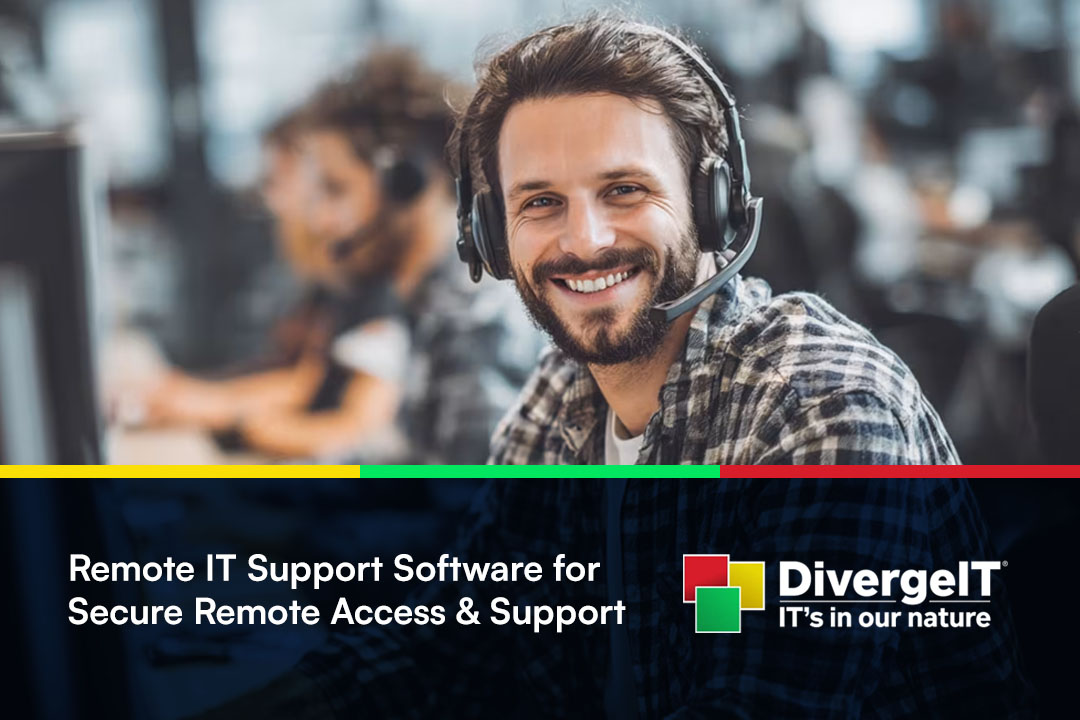July 10, 2025

Managing 100–300 endpoints comes with unique IT challenges. Remote IT support software helps businesses monitor, troubleshoot, and resolve issues quickly—without being physically present. This is especially important for growing businesses that need to scale support efficiently.
If you have 20 or more employees on your team, this blog is for you. We'll explore how remote IT support software works, its key features, and what to consider when choosing a solution. Topics like secure remote access, mobile device compatibility, and enterprise-level support are all covered.
Remote IT support software allows IT teams to access and manage devices from anywhere. It enables technicians to resolve issues, install updates, and monitor systems without needing to be onsite. This reduces downtime and improves productivity.
For small businesses and enterprises alike, remote IT support tools offer flexibility. Whether you're supporting Windows PCs, macOS, or Linux systems, these tools provide a centralized way to manage your IT environment. Many platforms also support mobile devices and offer secure connections through encryption and authentication protocols.

Remote IT support software includes a wide range of features. Below, we break down the most important ones to help you understand what to look for.
This feature allows IT staff to view and control a user's desktop in real-time. It's useful for troubleshooting issues directly on the user's machine.
Technicians can securely send or receive files during a support session. This helps when installing patches or retrieving logs for diagnostics.
Beyond viewing, remote control lets IT staff take full control of a device. This is essential for resolving complex issues that users can't fix themselves.
Some tools offer session recording for training or compliance purposes. It helps teams review what actions were taken during support sessions.
Many solutions support Windows, macOS, Linux, and mobile devices. This is important for businesses with a diverse IT environment.
Authentication ensures only authorized personnel can access devices. This adds a layer of security to your remote support solution.
Some platforms integrate with help desk software, streamlining the support process and improving response times.

Security is a top concern for any IT team. Remote IT support software must include features like encryption, multi-factor authentication, and access controls. These tools help prevent unauthorized access and protect company data.
Secure remote access also ensures compliance with industry regulations. Whether you're in healthcare, finance, or another regulated industry, having the right security features in place is non-negotiable.
There are many remote support tools available. Here's a breakdown of how they differ and what to consider.
TeamViewer is known for its ease of use and cross-platform support. It’s often used by both enterprises and small businesses.
Zoho Assist offers a free trial and is ideal for small businesses looking for cost-effective solutions with essential features.
RemotePC is suitable for both personal use and business environments. It supports remote desktop access and file transfer.
Enterprise-grade tools offer advanced features like role-based permissions, session recording, and integration with Active Directory.
Some providers offer limited free versions. These are useful for testing but may lack features needed for enterprise use.
Look for tools that support iOS and Android. This is important as more employees use mobile devices for work.
Good vendors offer onboarding, training, and 24/7 support. This helps your team get the most out of the software.

Start by identifying your business needs. Consider how many endpoints you need to support, what platforms you use, and your security requirements. Then, evaluate vendors based on features, pricing, and support.
Pilot the software with a small group before rolling it out company-wide. This helps identify any issues early and ensures a smoother transition. Make sure your team is trained and that security settings are properly configured.
If you're managing 100–300 endpoints, you need a remote IT support solution that scales with your business. At DivergeIT, we help companies like yours find and implement the right tools to support your team efficiently and securely.
We work with trusted vendors and provide hands-on support from setup to training. Whether you're looking for secure remote access, mobile device support, or enterprise-grade features, we can help you make the right choice.
Small businesses often need affordable and easy-to-use tools. The best remote access software for them includes features like remote control, file transfer, and mobile device support. These allow IT teams to troubleshoot issues quickly without being onsite.
Look for tools that offer encryption and authentication to protect sensitive data. Many vendors provide free trials so you can test before committing. This is especially helpful for companies managing 100–300 endpoints.
Remote desktop software allows IT teams to access and fix problems on user devices without delay. This reduces downtime and keeps employees productive. It also supports seamless collaboration across locations.
With features like session logging and remote control, IT staff can resolve issues faster. This is especially useful when managing multiple PCs across departments or remote offices.
Yes. Enterprises handle large volumes of sensitive data, so secure remote access is essential. It protects against unauthorized access and ensures compliance with regulations.
Security features like encryption, multi-factor authentication, and access controls are critical. These tools also help enterprises monitor and audit remote sessions effectively.
Yes, many remote support software tools offer personal use plans. These are ideal for helping friends or family with tech issues or accessing your own devices remotely.
While enterprise features may not be needed, basic tools like remote desktop and file transfer are still valuable. Some providers even offer free remote access options.
An excellent remote support solution includes fast connection times, intuitive interfaces, and multi-platform support. These features help IT teams resolve customer issues efficiently.
Look for tools that support mobile devices, offer session recording, and integrate with help desk platforms. These improve the overall support experience and customer satisfaction.
Yes, many vendors offer a free trial today. This allows you to test features like remote control, file transfer, and mobile device support before making a purchase.
Free trials are especially useful for small businesses and enterprises evaluating multiple solutions. They help ensure the tool meets your needs before full deployment.